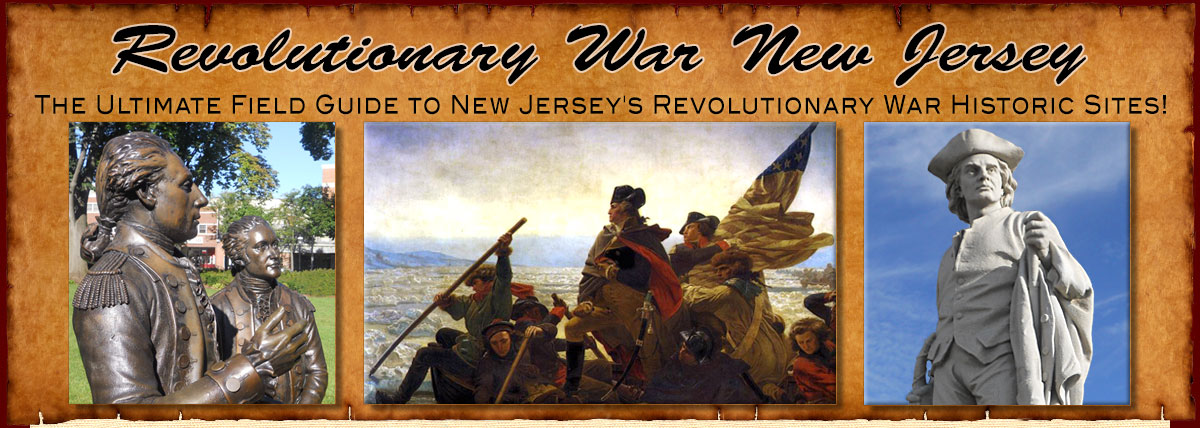

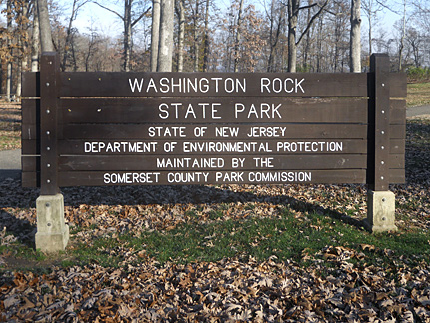
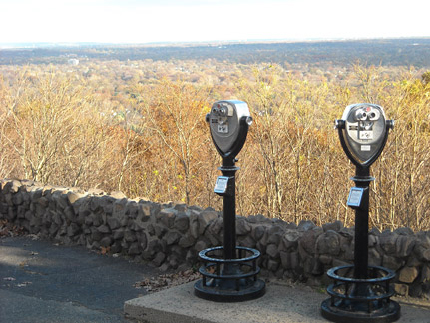
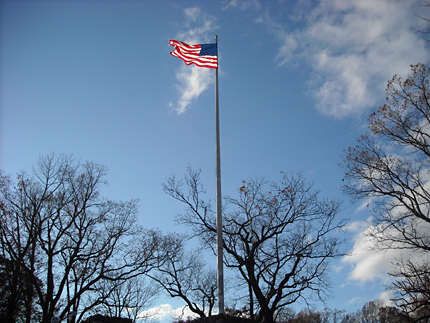
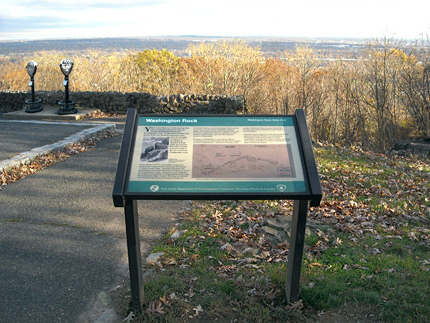
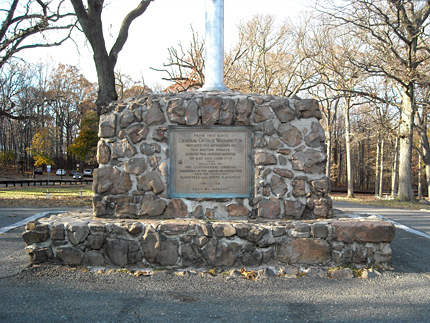
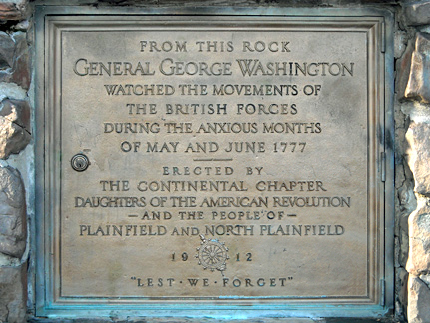
Washington Rock State Park
Washington Ave.
Where Washington Ave. meets Rock Rd.
Map / Directions to Washington Rock State Park
Washington Rock State Park webpage
"You are standing on a rocky outcrop that was a strategic lookout for General George Washington during the Revolutionary War. At that time, the land was mostly fields and meadows offering a clear view for 30 miles. In June of 1777, the ability to monitor British troop movements from this location proved crucial to the survival of the Continental Army."
- From a historic plaque at Washington Rock State Park [1]
The value of this location as a lookout is still plainly visible if you visit here on a clear day to experience the wonderful view. In June 1777, this site on the Watchung Mountains enabled General George Washington to observe activity to the east, including the thousands of British forces who had occupied New Brunswick since the previous December. At the time, Washington and the Continental (American) Army were encamped several miles to the southwest along the Watchung Mountains at Middlebrook,.
The British forces in New Brunswick greatly outnumbered the Continental Army troops at Middlebrook, but the protection of the Watchung Mountains made a British attack on the Continental Army impractical. With this in mind, the British General William Howe made an attempt to lure Washington's forces out of the mountains into the flatlands below, where superior troop strength would give the British the clear advantage.
On June 14, Howe moved thousands of troops west from New Brunswick to both sides of the Millstone River, in present day Millstone and Franklin Township. Howe's intent was to fool Washington into thinking that he was going to move his forces farther west to make an attack on Philadelphia, which was then the American capital. If he could lure Washington's troops from the security of the Watchung Mountains into a fight on the flatlands, the British superior troop strength would give them the advantage.
The British remained here for several days while General Washington kept an eye on their activities from the Watchung Mountains. However, by June 19 it was apparent to Howe that Washington would not be lured down from the mountains at this time, and the British forces returned to New Brunswick, without having provoked a battle with the Continental Army.
Over the next several days, circumstances did bring some of Washington's forces down from the Watchung Mountains, and the Battle of the Short Hills was fought in the flatlands below, mainly in the area of Edison and Scotch Plains. For more information about the Battle of the Short Hills, see the Scotch Plains page. [2]

1. ^ Washington Rock State Park Explanatory marker, placed by New Jersey Department of Environmental Protection - Division of Parks & Forestry.
2. ^ See the following contemporary sources regarding the events of June 14 - 19, 1777
• John André, Major André's Journal (Tarrytown, New York: William Abbatt, 1930) pages 25-29
Available to be read at the Hathi Trust Digital Library website here• Captain Johann Ewald, Translated and edited by Joseph P. Tustin, Diary of the American War - A Hessian Journal (New Haven and London: Yale University Press, 1979) page 64-67
▸ Page 67 shows a map of Hillsborough which is "believed to be the only contemporary map extant showing a part of General Howe's unsuccessful maneuver to lure Washington out of his strong positions into open warfare."
▸ ▸ Images of this map can be seen on the Bloomsburg University of Pennsylvania website here• "Road from Brunswick thro' Somerset to Van Vacter's Bridge. No 74, F" 1779 Map by Robert Erskine.
▸ Has a spot marked as Howe's 1777 headquarters in Middlebush (Franklin Township), near the property of Garrett Vorhees
▸ ▸ An image of this map can be seen on the NYU Digital Library Technology Services website here
• “General Orders, 14 June 1777,” Founders Online, National Archives (http://founders.archives.gov/documents/Washington/03-10-02-0029 [last update: 2015-12-30]). Source: The Papers of George Washington, Revolutionary War Series, vol. 10, 11 June 1777 – 18 August 1777, ed. Frank E. Grizzard, Jr. Charlottesville: University Press of Virginia, 2000, p. 33.
• “From George Washington to John Hancock, 14 June 1777,” Founders Online, National Archives (http://founders.archives.gov/documents/Washington/03-10-02-0032 [last update: 2015-12-30]). Source: The Papers of George Washington, Revolutionary War Series, vol. 10, 11 June 1777 – 18 August 1777, ed. Frank E. Grizzard, Jr. Charlottesville: University Press of Virginia, 2000, pp. 36–37.
• “From George Washington to Major General John Sullivan, 14 June 1777,” Founders Online, National Archives (http://founders.archives.gov/documents/Washington/03-10-02-0037 [last update: 2015-12-30]). Source: The Papers of George Washington, Revolutionary War Series, vol. 10, 11 June 1777 – 18 August 1777, ed. Frank E. Grizzard, Jr. Charlottesville: University Press of Virginia, 2000, pp. 40–41.
• “From George Washington to Major General John Sullivan, 14 June 1777,” Founders Online, National Archives (http://founders.archives.gov/documents/Washington/03-10-02-0039 [last update: 2015-12-30]). Source: The Papers of George Washington, Revolutionary War Series, vol. 10, 11 June 1777 – 18 August 1777, ed. Frank E. Grizzard, Jr. Charlottesville: University Press of Virginia, 2000, p. 41.
• “From George Washington to Major General Philip Schuyler, 16 June 1777,” Founders Online, National Archives (http://founders.archives.gov/documents/Washington/03-10-02-0055 [last update: 2015-12-30]). Source: The Papers of George Washington, Revolutionary War Series, vol. 10, 11 June 1777 – 18 August 1777, ed. Frank E. Grizzard, Jr. Charlottesville: University Press of Virginia, 2000, pp. 53–54.
• “From George Washington to Major General Benedict Arnold, 17 June 1777,” Founders Online, National Archives (http://founders.archives.gov/documents/Washington/03-10-02-0058 [last update: 2015-12-30]). Source: The Papers of George Washington, Revolutionary War Series, vol. 10, 11 June 1777 – 18 August 1777, ed. Frank E. Grizzard, Jr. Charlottesville: University Press of Virginia, 2000, pp. 58–61.
• “From George Washington to Major General Israel Putnam, 17 June 1777,” Founders Online, National Archives (http://founders.archives.gov/documents/Washington/03-10-02-0061 [last update: 2015-12-30]). Source: The Papers of George Washington, Revolutionary War Series, vol. 10, 11 June 1777 – 18 August 1777, ed. Frank E. Grizzard, Jr. Charlottesville: University Press of Virginia, 2000, pp. 62–63.
• “From George Washington to Brigadier Generals John Glover and Alexander McDougall, 20 June 1777,” Founders Online, National Archives (http://founders.archives.gov/documents/Washington/03-10-02-0083 [last update: 2015-12-30]). Source: The Papers of George Washington, Revolutionary War Series, vol. 10, 11 June 1777 – 18 August 1777, ed. Frank E. Grizzard, Jr. Charlottesville: University Press of Virginia, 2000, pp. 83–84.
• “From George Washington to John Hancock, 20 June 1777,” Founders Online, National Archives (http://founders.archives.gov/documents/Washington/03-10-02-0084 [last update: 2015-12-30]). Source: The Papers of George Washington, Revolutionary War Series, vol. 10, 11 June 1777 – 18 August 1777, ed. Frank E. Grizzard, Jr. Charlottesville: University Press of Virginia, 2000, pp. 84–86.
• For more information and accompanying source notes about the Middlebrook encampment, see the Washington Camp Ground / Middlebrook Encampment Site entry on the Bridgewater page.
• For more information and accompanying source notes about the Battle of the Short Hills, see the Battle of the Short Hills Monument entry on the Scotch Plains page.